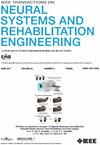Leveraging Extended Windows in End-to-End Deep Learning for Improved Continuous Myoelectric Locomotion Prediction
IF 4.8
2区 医学
Q2 ENGINEERING, BIOMEDICAL
IEEE Transactions on Neural Systems and Rehabilitation Engineering
Pub Date : 2025-03-18
DOI:10.1109/TNSRE.2025.3552530
引用次数: 0
Abstract
Current surface electromyography (sEMG) methods for locomotion mode prediction face limitations in anticipatory capability due to computation delays and constrained window lengths typically below 500 ms—a practice historically tied to stationarity requirements of handcrafted feature extraction. This study investigates whether end-to-end convolutional neural networks (CNNs) processing raw sEMG signals can overcome these constraints through extended window lengths (250 ms to 1500 ms). We systematically evaluate six window lengths paired with three prediction horizons (model forecasts 50 ms to 150 ms ahead) in a continuous locomotion task involving eight modes and 16 transitions. The optimal configuration (1000 ms window with 150 ms horizon) achieved subject-average accuracies of 96.93% (steady states) and 97.50% (transient states), maintaining 95.03% and 85.53% respectively in real-time simulations. With a net averaged anticipation time of 147.9 ms after 2.1 ms computation latency, this approach demonstrates that windows covering 74% of the gait cycle can synergize with deep learning to balance the inherent trade-off between extracting richer information and maintaining system responsiveness to changes in activity.利用扩展窗口在端到端深度学习改进连续肌电运动预测。
目前用于运动模式预测的表面肌电图(sEMG)方法由于计算延迟和通常低于500ms的受限窗口长度而面临预期能力的限制——这种做法历来与手工特征提取的平稳性要求有关。本研究探讨端到端卷积神经网络(cnn)处理原始表面肌电信号是否可以通过延长窗口长度(250ms至1500ms)克服这些限制。在涉及8种模式和16个过渡的连续运动任务中,我们系统地评估了6个窗口长度和3个预测范围(模型预测提前50ms至150ms)。最优配置(1000ms窗口和150ms水平)实现了96.93%(稳态)和97.50%(瞬态)的被测对象平均精度,在实时仿真中分别保持95.03%和85.53%。在2.1ms的计算延迟后,该方法的净平均预期时间为147.9ms,表明覆盖74%步态周期的窗口可以与深度学习协同,以平衡提取更丰富的信息和保持系统对活动变化的响应性之间的固有权衡。
本文章由计算机程序翻译,如有差异,请以英文原文为准。
求助全文
约1分钟内获得全文
求助全文
来源期刊
CiteScore
8.60
自引率
8.20%
发文量
479
审稿时长
6-12 weeks
期刊介绍:
Rehabilitative and neural aspects of biomedical engineering, including functional electrical stimulation, acoustic dynamics, human performance measurement and analysis, nerve stimulation, electromyography, motor control and stimulation; and hardware and software applications for rehabilitation engineering and assistive devices.

 求助内容:
求助内容: 应助结果提醒方式:
应助结果提醒方式:


